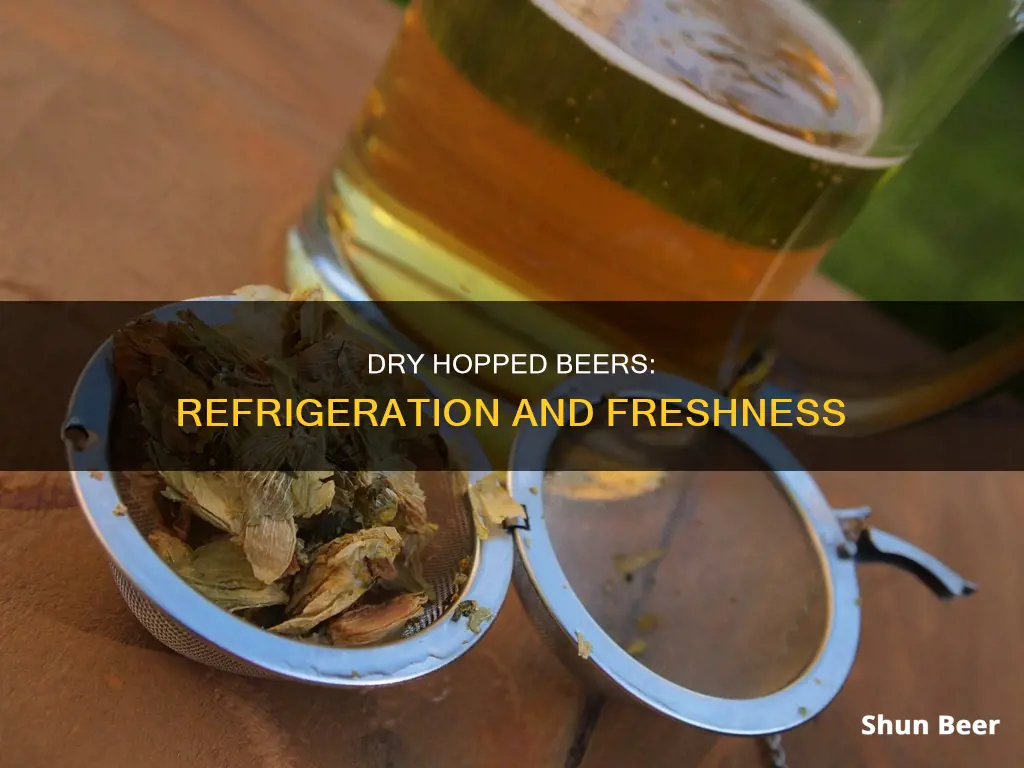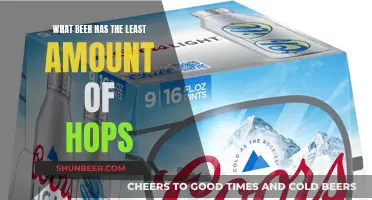
Beer is best preserved when kept cold, and dry-hopped beers are no exception. Dry hopping is the process of adding hops during or right after primary fermentation, to boost the hop aroma without enhancing bitterness. The delicate volatile oils that dry-hopped beers are known for do not survive a boil, so keeping these beers cool is crucial to maintaining their flavor and aroma. While temperature cycling has little effect on beer freshness, exposure to warm temperatures can affect a beer's flavor in a matter of days.
What You'll Learn

Beer tastes best when served at the correct temperature
Beer is best served between 3°C and 13°C, with the ideal temperature depending on the type of beer, serving method, and room temperature. Serving beer at the right temperature ensures maximum flavour and enjoyment.
Lagers are served at the bottom of the 3°C-13°C range, ales in the middle, and stouts at the top. Stronger and darker beers are served at warmer temperatures. For example, IPAs and American Pale Ales are best served at 7°C-10°C, while stouts and porters are best at 11°C-13°C.
Drinking method also affects the ideal serving temperature. Beer in a can will warm up faster than beer in a glass. Therefore, it is recommended to store beer 1°C-2°C below the intended drinking temperature to compensate for warming.
The effects of serving temperature on beer are both scientific and sensory. Scientifically, cold temperatures slow the volatilization of aromatic compounds, causing a loss of flavour and aroma. This effect is especially noticeable in beers with strong flavours, such as craft beers with high alcohol content. Warming these beers slightly enhances their flavour.
On the other hand, serving beer that is too warm can lead to a flat-tasting experience as the sensations from hop bitterness and carbonation decrease. Therefore, finding the ideal serving temperature for each type of beer is essential for getting the best flavour and sensory experience.
American Beer and Hops: Exploring the Connection
You may want to see also

Beer should be kept cool to prolong its shelf life
Beer is best kept cool to prolong its shelf life. Beer is an organic substance, and improper storage can cause its chemical compounds to break down, leading to spoilage.
Firstly, exposure to sunlight can cause a chemical reaction in beer, breaking down its flavour components. This results in the beverage smelling and tasting like skunk spray. Beer stored in clear or green bottles is particularly susceptible to this, as the light exposure speeds up the oxidation process.
Secondly, exposure to oxygen can also lead to a breakdown of the beer's chemicals, which can significantly alter its taste. Bottled beer is at a higher risk of oxygen exposure than canned beer, and storing beer upright minimises contact with the air.
Thirdly, the presence of bacteria can impact the shelf life of beer. Beer's high alcohol content acts as a natural preservative, but if bacteria is introduced, it will eat away at the beer. Refrigeration slows the life cycle of microbes that may be present in the beer, such as yeast.
Therefore, keeping beer cool and out of direct sunlight, and storing bottles and cans in an upright position, can help prolong its shelf life.
The Magical Four Ingredients of Beer Brewing
You may want to see also

Beer should be stored in the dark to avoid skunking
The reaction that causes skunking involves blue spectrum and some ultraviolet light in the sunshine interacting with certain compounds produced by hops, called isohumulones or iso-alpha acids. The reaction is slightly complex, but the result is the creation of a compound called 3-MBT, which gives off the "skunk" flavour.
Skunking can happen very quickly, especially in strong sunlight. For example, bottled beer can become lightstruck in less than a minute in bright sun, a few hours in diffuse daylight, and a few days under normal fluorescent light. Therefore, it is important to store beer in a dark place to avoid skunking.
Hops in Beer: Vegetable or Not?
You may want to see also

Beer in cans lasts longer than beer in bottles
Beer is a delicate beverage, and its flavour begins to change as soon as it's packaged. This is due to chemical reactions that break down flavour compounds while forming others, reducing the content of tasty flavours while generating unappetising ones. This process is called "skunking" and is caused by light strike, which is when blue spectrum and ultraviolet light in sunshine mess with certain compounds produced by hops, called isohumulones or iso-alpha acids.
To prolong the shelf life of beer, it should be stored in a cool, dark place, away from temperature fluctuations, and kept upright to minimise oxidation. When stored at room temperature, beer lasts about 5 to 9 months beyond the expiration date listed on the label. In a refrigerator, beer can last up to an additional two or three years, whether it's bottled or canned. However, once opened, beer has a shelf life of about a day, as oxidation quickly destroys the good flavours.
Kegging Beer: Reducing Hops for a Balanced Brew
You may want to see also

Beer should be stored upright to prevent yeast rings
Beer should always be stored upright to prevent yeast rings. Storing beer upright ensures that the yeast compact stays at the bottom of the bottle, minimising its influence on the flavour of the beer. This is especially important for bottle-conditioned beers, which still contain live yeast.
Storing beer upright also helps to slow the oxidation process. With the bottle upright, there is less surface area exposed to oxygen, which slows the rate of oxidation. This is true for both bottles and cans. Cans, however, are superior to bottles when it comes to preventing oxidation, as they have a tighter seal that prevents gases from escaping or entering the container.
Another reason to store beer upright is to prevent cork taint. When a corked beer is stored on its side, the alcohol in the beer can draw out mouldy or musty characters from the cork, tainting the beer. This is not an issue for modern plastic or synthetic corks, which are not prone to drying out.
Finally, storing beer upright helps to prevent "yeast rings" or watermarks from forming inside the bottle. These rings are caused by dead yeast cells and will not settle, making the beer unattractive and potentially ruining its taste.
The Magic of Malt and Hops in Beer
You may want to see also
Frequently asked questions
Dry-hopped beers are best kept refrigerated to maintain their flavour. Dry-hopping adds aroma and flavour to the beer without any bitterness. Keeping the beer refrigerated will help maintain the desired flavour for longer.
Dry-hopping is the process of adding hops during or right after primary fermentation. This technique boosts the aroma without enhancing bitterness.
Dry-hopping is a technique where hops are added late in the brewing process, either during fermentation or conditioning. Wet-hopping, on the other hand, refers to the use of freshly picked hops during any stage of the brewing process on the same day they are harvested.
Beer is best preserved when kept cold. Exposure to warm temperatures can significantly reduce its shelf life and affect its flavour. Keeping beer refrigerated helps maintain the flavour as intended by the brewer.
The ideal temperature for storing beer is around 55 degrees Fahrenheit, similar to the temperature of a traditional wine or beer cellar. While some mass-market beers are best served icy, most craft beers are best served at warmer temperatures to bring out their full flavour.







